A new perspective … from 13,000 feet.
On Saturday, I finally got the chance to do something I’ve long waited for – Sky Diving.
That’s right. Climbing well past the height where airplanes allow you to remove your seatbelts. Jumping from said perfectly good airplane. Throwing myself to the ground at 120 mph.
As soon as we landed, all I could think about was doing it again.
We picked http://www.skydivekapowsin.com as our drop zone, as they offer the best rates, the highest jumps, and a great view. They do tandem jumps from 13,000 ft (weather permitting,) unlike many other places that only take you to 8,000 with the base rate.
Tandem jumps have you strapped to the front of your instructor, and are by far the best value for your first time. You don’t participate much in the mechanics of the jump, so you go much higher – and get much more time in the air. The alternative is a “static line” jump, where your parachute is automatically deployed as you exit the aircraft. You do the jump (and land) on your own, but only from about 4,000 ft.
We arrived at Pierce County Airport for our reservations at 11:00, shortly after the morning haze burned off. We couldn’t have asked for better weather, as they sky was cloudless and almost crystal blue. Mt Rainier loomed impressively to the southwest – its summit just a few hundred feet higher than our ultimate altitude.
After waiting about half an hour for a load to come back, one of the owners suited us up with jump harnesses, helmets, and goggles. We strapped ourselves in – tightly, so that we didn’t continue to travel when the harness stopped as the parachute deployed.
An instructor gave us instructions on proper exit protocol, free-fall queues, and landing technique just before we paired with our jump masters to board the airplane. All signals and queues are physical – in freefall, the roaring wind makes voice communication about as effective as telepathy. My jump master was April Ashley: technically excellent, fun, and and all-around great person.
After getting organized, we boarded the idling Twin Otter – a powerful, large-capacity plane that easily took us to 13,000 ft. As I mentioned earlier, many sky diving outfits only take you to 8,000 ft, and charge a lot extra to go to 10,000 ft. This is because they fly a Cessna 182, with a much smaller engine. It climbs quickly to 6,000 ft, but labours the rest of the way. The Twin Otter climbs the entire 13,000 ft at the same rate that the Cessna makes its first 6,000.
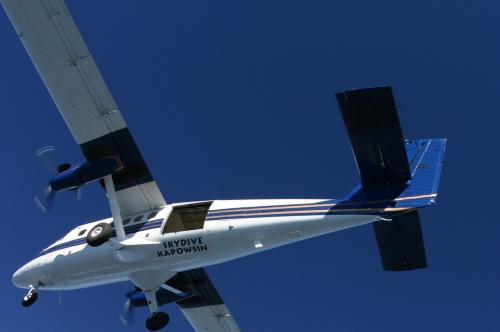 [ http://www.skydivekapowsin.com/Web%20photos/DK-Paul.JPG ]
[ http://www.skydivekapowsin.com/Web%20photos/DK-Paul.JPG ]
There were about 15 of us – facing each other as we sat on long benches that ran the length of the aircraft. I looked up and down the two rows of my companions – surprisingly everybody looked eager to do this. I was extremely excited and chatty – feeling the impatient expectation you get before a huge amusement park ride.
After taxiing onto the runway, we buckled up as our pilot applied full throttle. The loud din of dual propellers overwhelmed our conversation as the plane quickly picked up speed. Talk subsided, as we watched the ground begin to blur beside us. After a few moments, we felt the familiar heaviness of the plane pulling skyward, lifting from the ground. “Wow, we’re high,” I thought, not even 1,000 ft from the ground.
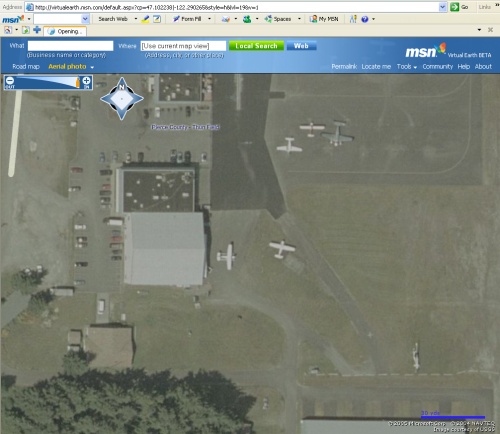 [ http://virtualearth.msn.com/default.aspx?cp=47.102238|-122.290265&style=h&lvl=19&v=1 ]
[ http://virtualearth.msn.com/default.aspx?cp=47.102238|-122.290265&style=h&lvl=19&v=1 ]
We started chatting again – although chatting doesn’t really describe yelling over the noise of a propeller-driven airplane. April pointed out the magnificent scenery rapidly becoming visible. Mount St. Helens was now readily apparent, as was Mount Olympus. Streams sparkled in the morning sunlight, shining as though laden with silver ore.
I glanced at the altimeter. “Wow, we’re high,” I thought, just now approaching 8,000 ft. “You know,” I joke-screamed. “We’re the most prepared we could ever be for plane troubles.” “If the plane had any issues and we had to jump – our only regret would be that it wasn’t higher!”
As we started to approach our ultimate altitude of 13,000 ft, the Twin Otter cut broad circles in the sky as it continued its aggressive climb. Our jump masters tightly joined our harnesses with theirs – essentially strapping us to their laps. Each of the four connection points could bear the entire load many times over.
As we reach 13,000 ft, one of the operators slides the jump door of the aircraft up. Cold air streams in, as I get my first glance of the patchwork quilt of green and gold that lays below us. Thrill pours over me in anticipation. The camera man exits first, followed shortly by a few individual advanced sky divers. April and I nudge up along the bench toward the front of the airplane, and then approach the window. I hold my chest harness, minimizing the amount I contribute to our aerodynamics. After a few moments of preparation, we jump into the enormous blast of rushing wind. I arch my back and curl my legs rearward as April stabilizes us. My mind, overwhelmed by pleasure and stimulus, spins in excitement.
April gives a hearty cheer, as she turns us left, then right. The enormous vista spins beneath me, as I absorb the immense, rushing view.
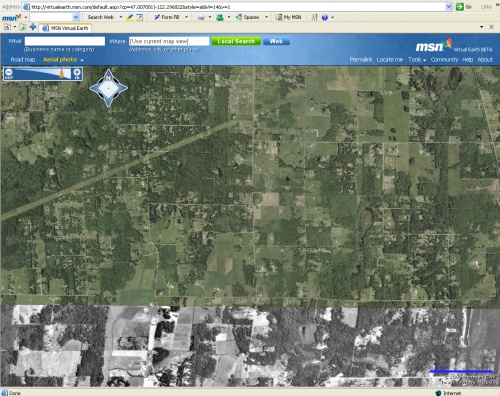
[ http://virtualearth.msn.com/default.aspx?cp=47.007081|-122.296822&style=a&lvl=14&v=1 ]
The wind tries to force its way down my throat, but a firmly planted toothy smile prevents it. My heart beats heavily – not in panic, but pure, unadaultered joy.
After about 60 seconds, April taps me, giving me the signal to extend my arms. This slows our descent, as she prepares to deploy the parachute. She pulls the rip cord, and the parachute deploys. We quickly (but gently) decelerate from 120 MPH to about 20 MPH. From this point on, it’s some leisurely fun-time in the air.
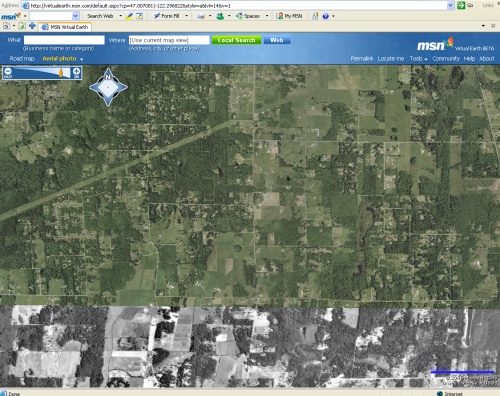
[ http://virtualearth.msn.com/default.aspx?cp=47.00725|-122.297159&style=a&lvl=16&v=1 ]
We’re at about 6,000 ft now, as April shows me how to use the toggles that control the parachute – handles attached to the rigging of the canopy. One goes in each hand. With both arms up, you accelerate forward. With both arms down, you slow down. With one arm down (and the other up,) you turn in the direction of your down arm.
She spins us around for a bit, pulling us deeper into our harnesses with the G forces. She offers me the handles, which I gladly accept – although slightly anxious about making a mistake. I put us into a hard spiral, extracting another hearty cheer from us both. I thoroughly enjoy myself at the controls – changing speed and direction at a whim.
After about 3 or 4 minutes of this, April takes the toggles again in preparation for our approach. We’re about 2,000 ft from the ground, targeting the cleanly-mowed landing area to the right of the pond, at the bottom-left of the picture below:
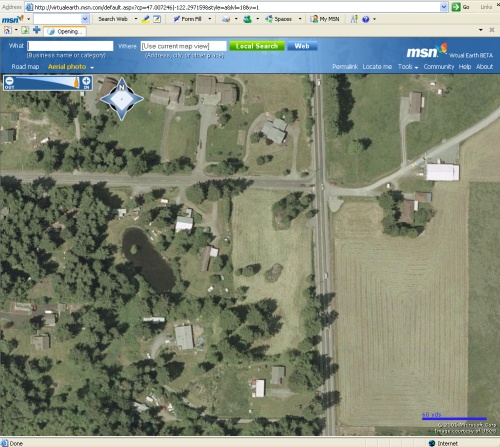
[ http://virtualearth.msn.com/default.aspx?cp=47.007246|-122.297159&style=a&lvl=18&v=1 ]
After more of my non-stop talking, April nicely asks me to be quiet so that she can concentrate on the task at hand.
A few moments later, we finally touch earth again – sliding on our heels, and then gently falling onto to our butts. Running landings are out of vogue these days, as they tend to cause ankle injuries.
I spring to my feet, thanking April heartily. I can barely contain my enthusiasm, already wondering how soon again I can go.
I found this video that gives a very realistic portrait of somebody else’s jump, just like mine: http://www.skydivedelmarva.com/students/graphics/t/tandem%20skydive.wmv
